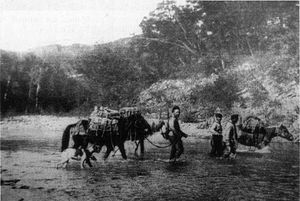Vladimir K Arsenyev was an army officer, explorer and writer active in Russia’s Far East in the waning years of the Romanov dynasty. His major claim to fame, outside Russia at any rate, is having introduced the world to the aboriginal hunter and trapper Dersu Uzala, who several decades later became the subject of an Oscar-winning film by Akira Kurosawa.
Arsenyev undertook several expeditions in the mountainous region roughly between Vladivostok and the Chinese border in the first years of the 20th century, ostensibly to survey the region’s infrastructure. But Arsenyev’s extensive field journals became the basis of two books of what would now be called “travel literature.” Across the Ussuri Kray: Travels in the Sikhote-Alin Mountains was the first of these. Published in Vladivostok in 1921 in the midst of the Russian Civil War, it is the account of of two separate expeditions in 1902 and 1906. This volume is available in a new translation by Jonathan C. Slaght.
The history of Arsenyev’s publications is apparently somewhat torturous: they were subject to considerable editing, censorship, redaction, and amalgamation by Soviet authorities after their first publication, and these versions provided the basis of the later English translations. But in 2007, the full unedited editions were republished in Russia. Not only does Slaght make this material available in English for the first time, but he does so in a translation that, in its fluency and readability, stands comparison with English-language classics of the genre.
There are adventures — tigers, bears and several near-death experiences, including almost freezing in a blizzard — and considerable detailed observation of geography, flora, and fauna. Arsenyev has great powers of description:
Everything was covered in fog to the east as far as the eye could see. The peaks of adjacent mountains looked like disconnected islands. Waves of mist flung themselves at the mountain ridge, but once they passed through the saddle and reached the western slope, they disappeared, because there the air was clean and transparent.
Slaght, himself a conservationist who has worked extensively in the region, carefully identifies each species, mineral, and geographical feature in the footnotes.
But the general reader is likely to be more attracted by the interactions with the many people — Chinese, Korean, and indigenous — that Arsenev comes across. These include villagers, farmers, ginseng hunters, and the now-famous Dersu Uzala, who accompanies Arsenyev through the greater part of both expeditions. Or so goes the narrative; Arsenyev didn’t actually meet the indigenous Nanai hunter until the second expedition and his appearance in the first is apparently a narrative device.
Overlooking this — and, the book notes, some other departures from a strictly factual account — the great strength and appeal of the narrative is these two well-defined personalities and their evidently close relationship. Dersu Uzala is an animist; Arsenyev is much taken by his companion’s world view. In one particularly touching passage, Dersu explains that one cannot kill flying squirrels for they
… embody the souls of dead children. These souls wander the earth for some time in the form of a flying squirrel, and only later do they transition to the other world…
Arsenyev’s observations — which result in considerable introspection, which he shares with us — are more personal than ethnographic or sociological, yet he comments in detail on the relations, not always healthy, between the different ethnic groups, including considerable criticism of the commercial thrall in which Chinese traders hold some of the indigenous groups. Indeed, it comes as something of a surprise to find the narrative populated by as many or more Chinese and Koreans as ethnic Russians.
But of course, the region had been under Chinese sway for centuries before it was ceded to Russia only some 50 years previously. Arsenyev notes the many place names with Chinese origins and describes Chinese trading establishments that predate the arrival of the Russians. Arsenyev might have been exploring, but it seems the Chinese already knew where everything was — as, of course, did Dersu.
If Arsenyev’s expeditions were military, one would not know from these accounts; concrete objectives are rarely if even mentioned, nor is the fact that Russia fought and lost a major war between his two expeditions.
Slaght has done Arsenyev proud. The smooth translation doesn’t read like one: it is seamless and colloquial while remaining entirely in tune with the style of period in which it was written. The only slightly jarring note is that Slaght has Dersu speak ungrammatically in a sort of pidgin: “my” for “I”, and leaving words out. One imagines Arsenyev did something similar, but in Russian; the English feels a bit artificial.
Slaght is fastidious in his annotations of botanical, zoological, geographical, and historical detail, even to the point of rather quaintly explaining what a samovar is. The book also includes a number of fascinating original photos.
Vladimir Arsenyev deserves a place on the shelf next to such writers as Peter Hopkirk and Wilfred Thesiger; if he ends up there, he’ll have Slaght to thank.
Peter Gordon is editor of The Asian Review of Books, where this piece originally appeared. You can view the original here.

































